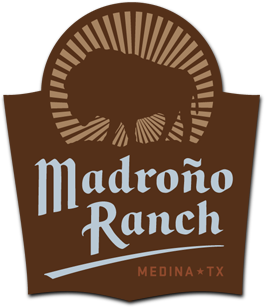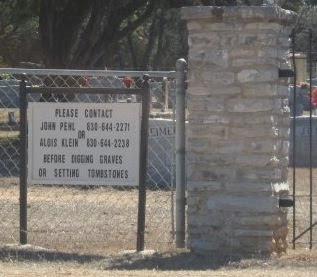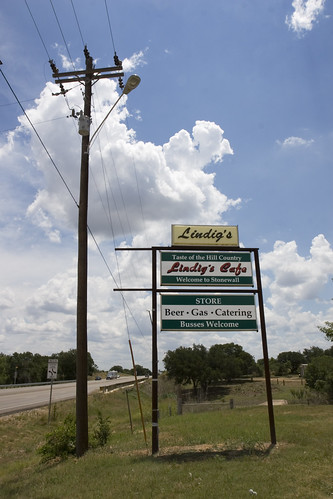There must be a story behind the sign at the front gate of the Stonewall Community Cemetery—I mean, who digs a new grave in a cemetery without permission?—but I don’t know it. Even though I wrote the entry on Stonewall for the New Handbook of Texas almost twenty years ago, I never saw the sign until last fall, because I’d never taken the time to go out there and poke around the town. (Even then, I only did so at the urging of our friend Dennis Fagan, a terrific photographer who’s been documenting the town’s annual Peach JAMboree for thirty years now.)
Stonewall, a town of some 470 people on the Pedernales River in Gillespie County and the self-proclaimed “Peach Capital of Texas,” marks the halfway point of the two-and-a-half-hour drive between Austin and Madroño Ranch. It’s one of the places we usually speed through without stopping on our way to or from the ranch, a wide spot in the road between Johnson City and Fredericksburg.
I suspect that is most people’s experience of Stonewall. Some may stop for gas, or to buy peaches at one of the numerous roadside stands, but the average driver who whizzes past on Highway 290 is too intent on reaching Austin or Fredericksburg to think much about Stonewall. If the town registers on his or her consciousness at all, it is as an annoyance, because the speed limit drops from 70 to 55 miles per hour there.
The chamber of commerce, having somewhat arbitrarily selected 1860 as the date of the town’s founding, will celebrate Stonewall’s sesquicentennial this year, but many accounts date the town’s birth to some time around 1870. That’s when Israel Nunez, a Jewish transplant from the state of Georgia, established a stagecoach stop a couple of miles south of the current town. Initially Major Nunez, as he was known, collected mail for the scattered local settlers from passengers traveling between San Marcos, Blanco, and points west, but by 1875 the local population had increased to the point that an actual post office was established there, and Nunez insisted it be called Stonewall, after Thomas J. “Stonewall” Jackson, under whom he’d served during the War of Northern Aggression.
Or so the story went. The reality, it appears, was slightly different. Israel Moses Nunez, born in Florida in 1838, was the third child and oldest surviving son of Raphael J. Moses, Confederate general James Longstreet’s chief supply officer and a pioneer of the commercial peach industry in Georgia—an interesting historical note, that, given the future importance of peaches to Stonewall.
Raphael changed his son’s surname to Nunez to perpetuate the family’s Sephardic heritage; “Major” turns out to have been Israel’s childhood nickname, rather than his military rank. In 1906, his younger brother recalled, “When we moved to Columbus [Georgia] in 1849, Israel had on his first pair of boots and he was so proud of them and strutted so up and down the deck showing them off that all the passengers nicknamed him the ‘Major,’ a name which has curiously held on to him the balance of his life.” (Perhaps coincidentally, major was also the rank his father held in the Confederate army.)
Moreover, Israel never actually served under Jackson. He didn’t enlist as a private in William W. Parker’s Virginia artillery battalion until December 1863—a full seven months after Stonewall was cut down by “friendly fire” at Chancellorsville. Israel did serve in the trenches during the siege of Petersburg, but he was back home in Georgia when the war ended. Sometime thereafter he and his wife Anna Marie, who bore him eleven children between 1860 and 1883, moved from Columbus to what was then considered western Texas.
Of course, whether or not he actually served under Jackson, there’s no reason he shouldn’t have named his new home after the Confederate hero. As for the persistence of the nickname “Major,” well, perhaps he didn’t go out of his way to correct those who assumed he’d attained that rank in the Confederate army, but then the post-Civil War years saw a fair amount of romantic historical revisionism. He and his family moved to Austin in 1890, and he died fifteen years later. Israel and Anna Marie Nunez are buried in one of the Jewish sections of Austin’s Oakwood Cemetery.
In 1924, when Highway 290 was completed between Austin and Fredericksburg, Stonewall hosted the official celebration. Thirty-three years later, the highway was moved four hundred yards to the south, and several businesses followed it. Most people who know Stonewall from the establishments along Highway 290—peach stands like Burg’s Corner, Gold Orchards, Vogel Orchards; restaurants like Lindig’s Café and the One Stop diner; vineyards like Becker, Grape Creek, and Woodrose—might not even realize that the town also boasts a number of establishments aimed primarily at the town’s inhabitants rather than tourists: the Trinity Lutheran, St. Francis Xavier Catholic, and Stonewall Baptist churches; Nielsen Automotive, Stonewall Body Shop, and Eckert and Son Used Auto Parts; the Stonewall Smokehouse; Weinheimer and Son general merchandise; Stonewall Mutual Farm Insurance; the Stonewall Volunteer Fire Department; Stonewall Head Start; Gordon’s Welding; J. Bolton and Associates wholesale furniture; Vogel Tractors.
Similarly, my Handbook of Texas entry on Stonewall, while more or less accurate as far as it goes, doesn’t come close to giving the flavor of the place. Nowhere in it do you learn that the locals are trying desperately to keep the peach industry going in the face of terrible and persistent drought; that they’re facing pressure to quit growing peaches in favor of grapes, that pernicious totem of yuppie agritourism; that as the memory of local boy LBJ fades further into the past, the number of visitors to the nearby Lyndon B. Johnson National Historical Park keeps dwindling. What’s missing from that entry, in other words, is the real human drama you can find in Stonewall right now, every day, if you just know where and how to dig.
What we’re reading
Heather: Richard Rohr, The Naked Now: Learning to See as the Mystics See
Martin: Spike Carlsen, A Splintered History of Wood: Belt Sander Races, Blind Woodworkers, and Baseball Bats



martin, hi – nikki again…
these stories are so rich and fun – we'd love for you to consider contributing to the life sciences section on W5RAn.com
we are looking for images and snippets of life and the madrono ranch 'free range' aesthetic seems a very good fit!